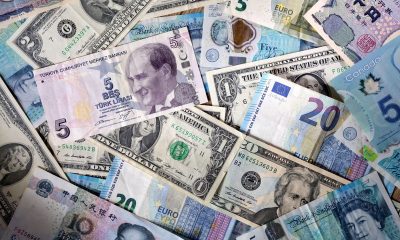Forex
Asia FX muted ahead of US inflation data; USDJPY nears 152

Investing.com– Most Asian currencies moved little on Tuesday and the dollar steadied in anticipation of key U.S. inflation data due later this week, while the Japanese yen moved back towards 34-year lows despite repeated warnings of government intervention.
Traders remained largely wary of making big bets in anticipation of more cues on U.S. interest rates. Asian markets were also still reeling from a bumper reading on Friday, which saw traders further price out expectations of early interest rate cuts by the Federal Reserve.
The payrolls data kept the dollar trading strong, and also pushed up U.S. Treasury yields, which in turn weighed on Asian currencies.
USDJPY moves back towards 152 despite intervention threats
The Japanese yen weakened slightly on Tuesday, with the pair now moving back towards the 152 level- its highest since 1990.
Weakness in the yen came even as Japanese officials repeatedly warned that they will respond appropriately to speculation against the yen. But the odds appeared stacked against the yen, especially in the face of higher-for-longer U.S. interest rates, which have been a key weight on the Japanese currency for nearly two years.
The yen also took little support from the Bank of Japan’s first rate hike in 17 years, given that the central bank offered largely dovish signals on future policy decisions.
Dollar steadies with CPI data, Fed minutes in focus
The and moved little in Asian trade after clocking some overnight losses. But traders still remained largely biased towards the greenback ahead of more signals on U.S. interest rates this week.
inflation data for March is due on Wednesday and is widely expected to show inflation remaining comfortably above the Fed’s 2% annual target, giving the central bank little impetus to begin trimming rates early.
The are also due on Wednesday, and come amid growing doubts over whether the central bank will begin cutting interest rates in June.
A slew of Fed officials warned that sticky inflation will keep the Fed from cutting rates early this year.
This notion weighed on most Asian currencies, keeping them in a tight range on Tuesday. The Australian dollar’s pair fell slightly, as data showed worsened in early-April.
The Chinese yuan’s pair remained well above the 7.2 level, as the currency was hit with increased selling on growing doubts over a Chinese economic recovery.
The South Korean won weakened, with the pair rising 0.1%, while the Singapore dollar’s pair tread water.
The Indian rupee’s pair moved little and remained close to record highs above the 83 level.

 Forex3 years ago
Forex3 years agoForex Today: the dollar is gaining strength amid gloomy sentiment at the start of the Fed’s week

 Forex3 years ago
Forex3 years agoUnbiased review of Pocket Option broker

 Forex3 years ago
Forex3 years agoDollar to pound sterling exchange rate today: Pound plummeted to its lowest since 1985

 Forex3 years ago
Forex3 years agoHow is the Australian dollar doing today?

 Cryptocurrency3 years ago
Cryptocurrency3 years agoWhat happened in the crypto market – current events today

 World3 years ago
World3 years agoWhy are modern video games an art form?

 Commodities3 years ago
Commodities3 years agoCopper continues to fall in price on expectations of lower demand in China

 Economy3 years ago
Economy3 years agoCrude oil tankers double in price due to EU anti-Russian sanctions


























